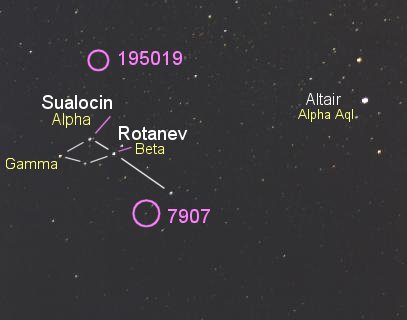 HD 195019 is a double star, which makes it unusual for a planet
host. The planet orbits the brighter primary star, the fainter
companion at least 150 AU away.
HD 195019 is a double star, which makes it unusual for a planet
host. The planet orbits the brighter primary star, the fainter
companion at least 150 AU away.
THE PLANET
The upper circle shows the location of the class G subgiant-dwarf
star HD 195019, found in the constellation Delphinus. The planet, whose mass is at least 3.43
times that of Jupiter, orbits with a very short period of only 18.3
days at an average distance of just 0.14 Astronomical Units (21
million kilometers, 13 million miles, 36 percent the distance of
Mercury from the Sun), the proximity to its star making it a "hot
Jupiter." Consistently, the orbit is close to circular, the
eccentricity only about 5 percent.
|
 HD 195019 is a double star, which makes it unusual for a planet
host. The planet orbits the brighter primary star, the fainter
companion at least 150 AU away.
HD 195019 is a double star, which makes it unusual for a planet
host. The planet orbits the brighter primary star, the fainter
companion at least 150 AU away.
 HD 195019 is a double star, which makes it unusual for a planet
host. The planet orbits the brighter primary star, the fainter
companion at least 150 AU away.
HD 195019 is a double star, which makes it unusual for a planet
host. The planet orbits the brighter primary star, the fainter
companion at least 150 AU away.